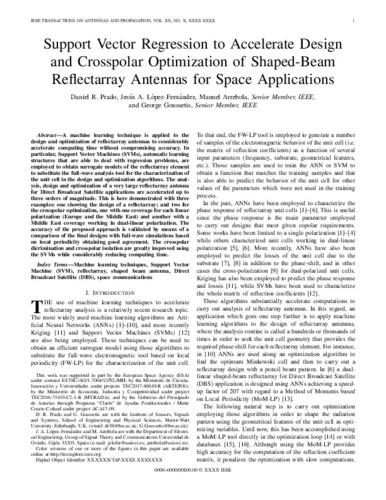Support Vector Regression to Accelerate Design and Crosspolar Optimization of Shaped-Beam Reflectarray Antennas for Space Applications
Autor(es) y otros:
Palabra(s) clave:
Machine learning techniques
Support Vector Machine (SVM)
shaped beam antenna
antenna
satellite communications
Direct Broadcast Satellite (DBS)
reflectarray
Fecha de publicación:
Versión del editor:
Citación:
Descripción física:
Resumen:
A machine learning technique is applied to the design and optimization of reflectarray antennas to considerably accelerate computing time without compromising accuracy. In particular, Support Vector Machines (SVMs), automatic learning structures that are able to deal with regression problems, are employed to obtain surrogate models of the reflectarray element to substitute the full-wave analysis tool for the characterization of the unit cell in the design and optimization algorithms. The analysis, design and optimization of a very large reflectarray antenna for Direct Broadcast Satellite applications are accelerated up to three orders of magnitude. This is here demonstrated with three examples: one showing the design of a reflectarray; and two for the crosspolar optimization, one with one coverage for each linear polarization (Europe and the Middle East) and another with a Middle East coverage working in dual-linear polarization. The accuracy of the proposed approach is validated by means of a comparison of the final designs with full-wave simulations based on local periodicity obtaining good agreement. The crosspolar dicrimination and crosspolar isolation are greatly improved using the SVMs while considerably reducing computing time.
A machine learning technique is applied to the design and optimization of reflectarray antennas to considerably accelerate computing time without compromising accuracy. In particular, Support Vector Machines (SVMs), automatic learning structures that are able to deal with regression problems, are employed to obtain surrogate models of the reflectarray element to substitute the full-wave analysis tool for the characterization of the unit cell in the design and optimization algorithms. The analysis, design and optimization of a very large reflectarray antenna for Direct Broadcast Satellite applications are accelerated up to three orders of magnitude. This is here demonstrated with three examples: one showing the design of a reflectarray; and two for the crosspolar optimization, one with one coverage for each linear polarization (Europe and the Middle East) and another with a Middle East coverage working in dual-linear polarization. The accuracy of the proposed approach is validated by means of a comparison of the final designs with full-wave simulations based on local periodicity obtaining good agreement. The crosspolar dicrimination and crosspolar isolation are greatly improved using the SVMs while considerably reducing computing time.
ISSN:
Patrocinado por:
This work was supported in part by the European Space Agency (ESA) under contract ESTEC/AO/1-7064/12/NL/MH; by the Ministerio de Ciencia, Innovación y Universidades under projects TEC2017-86619-R (ARTEINE); by the Ministerio de Economía, Industria y Competitividad under project TEC2016-75103-C2-1-R (MYRADA); and by the Gobierno del Principado de Asturias through Programa “Clarín” de Ayudas Postdoctorales / Marie Courie-Cofund under project ACA17-09.
Colecciones
Ficheros en el ítem




